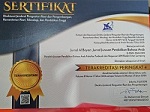The Students' Perspective Towards YouTube as the Replacement of Lecturer in Nahwu Learning
Abstract
Keywords
Full Text:
PDFReferences
Affouneh, Saida, Soheil Salha, and Zuheir N. Khlaif. “Designing Quality E-Learning Environments for Emergency Remote Teaching in Coronavirus Crisis.” Interdisciplinary Journal of Virtual Learning in Medical Sciences 11, no. 2 (June 1, 2020): 135–37. https://doi.org/10.30476/ijvlms.2020.86120.1033.
Ahmadi, Ahmadi, and Aulia Mustika Ilmiani. “The Use of Teaching Media in Arabic Language Teaching During Covid-19 Pandemic.” Dinamika Ilmu: Jurnal Pendidikan 20, no. 2 (December 1, 2020): 307–22. https://doi.org/10.21093/di.v20i2.2515.
Aliyah, Aliyah. “Pesantren Tradisional Sebagai Basis Pembelajaran Nahwu Dan Sharaf Dengan Menggunakan Kitab Kuning.” Al-Ta’rib : Jurnal Ilmiah Program Studi Pendidikan Bahasa Arab IAIN Palangka Raya 6, no. 1 (June 1, 2018): 1–25. https://doi.org/10.23971/altarib.v6i1.966.
Alobaid, Azzam. “Smart Multimedia Learning of ICT: Role and Impact on Language Learners’ Writing Fluency— YouTube Online English Learning Resources as an Example.” Smart Learning Environments 7, no. 1 (September 15, 2020): 24. https://doi.org/10.1186/s40561-020-00134-7.
Anisimova, Olga V., Lola K. Bobodzhanova, Kseniya S. Kolobova, and Inna S. Makarova. “Integration of Internet Tools to Enhance Pronunciation Skills: Effectiveness of Educational Content on YouTube.” In Integrating Engineering Education and Humanities for Global Intercultural Perspectives, edited by Zhanna Anikina, 199–211. Lecture Notes in Networks and Systems. Cham: Springer International Publishing, 2020. https://doi.org/10.1007/978-3-030-47415-7_21.
Bakar, Sulaila, Rosita Aminullah, Jun Nirlawati Mohd Sahidol, Nik Ismail Harun, and Azlini Razali. “Using YouTube to Encourage English Learning in ESL Classrooms.” In Proceedings of the Regional Conference on Science, Technology and Social Sciences (RCSTSS 2016), edited by Mohd Yusri Mohamad Noor, Badli Esham Ahmad, Mohd Rozaidi Ismail, Hasnizawati Hashim, and Mohd Amli Abdullah Baharum, 415–19. Singapore: Springer, 2019. https://doi.org/10.1007/978-981-13-0203-9_38.
Clandinin, D. J., and J. Huber. “Narrative Inquiry.” In International Encyclopedia of Education (Third Edition), edited by Penelope Peterson, Eva Baker, and Barry McGaw, 436–41. Oxford: Elsevier, 2010. https://doi.org/10.1016/B978-0-08-044894-7.01387-7.
Corbera, Esteve, Isabelle Anguelovski, Jordi Honey-Rosés, and Isabel Ruiz-Mallén. “Academia in the Time of COVID-19: Towards an Ethics of Care.” Planning Theory & Practice 21, no. 2 (March 14, 2020): 191–99. https://doi.org/10.1080/14649357.2020.1757891.
El Miedany, Yasser. “Social Media and YouTube.” In Rheumatology Teaching: The Art and Science of Medical Education, edited by Yasser El Miedany, 305–26. Cham: Springer International Publishing, 2019. https://doi.org/10.1007/978-3-319-98213-7_16.
Erekson, David M., Russell J. Bailey, Kara Cattani, Sheilagh T. Fox, and Melissa K. Goates-Jones. “Responding to the Covid-19 Pandemic at a University Counseling Center: Administrative Actions, Client Retention, and Psychotherapy Outcome.” Counselling Psychology Quarterly 0, no. 0 (August 17, 2020): 1–15. https://doi.org/10.1080/09515070.2020.1807914.
Felix, Cathrine V. “The Role of the Teacher and AI in Education.” In International Perspectives on the Role of Technology in Humanizing Higher Education, edited by Enakshi Sengupta, Patrick Blessinger, and Mandla S. Makhanya, 33:33–48. Innovations in Higher Education Teaching and Learning. Emerald Publishing Limited, 2020. https://doi.org/10.1108/S2055-364120200000033003.
Geier, Michael T. “Students’ Expectations and Students’ Satisfaction: The Mediating Role of Excellent Teacher Behaviors.” Teaching of Psychology 48, no. 1 (January 1, 2021): 9–17. https://doi.org/10.1177/0098628320959923.
Ghobrini, R. El A. “Synergizing Facebook and YouTube for E-Teaching Grammar during Covid-19 Pandemic.” International Journal of Education and Science 3, no. 4 (November 30, 2020): 33. https://doi.org/10.26697/ijes.
Hakim, Arif Rahman. “Mempermudah Pembelajaran Ilmu Nahwu Pada Abad 20.” Jurnal Al Maqayis 1, no. 1 (September 2, 2014). https://doi.org/10.18592/jams.v1i1.96.
Hamidah, Hamidah, and Marsiah Marsiah. “Pembelajaran Maharah Al-Istima’ Dengan Memanfaatkan Media YouTube: Problematika Dan Solusi.” Al-Ta’rib : Jurnal Ilmiah Program Studi Pendidikan Bahasa Arab IAIN Palangka Raya 8, no. 2 (December 2, 2020): 147–60. https://doi.org/10.23971/altarib.v8i2.2282.
Hammersley, Martyn, and Anna Traianou. Ethics in Qualitative Research: Controversies and Contexts. SAGE, 2012.
Harrison, Roger A., Annie Harrison, Christine Robinson, and Barbara Rawlings. “The Experience of International Postgraduate Students on a Distance-Learning Programme.” Distance Education 39, no. 4 (October 2, 2018): 480–94. https://doi.org/10.1080/01587919.2018.1520038.
Huberman, Michael, and Matthew B. Miles. The Qualitative Researcher’s Companion. SAGE, 2002.
Idzhar, Ahmad. “Peranan Guru Dalam Meningkatkan Motivasi Belajar Siswa.” Jurnal Office 2, no. 2 (December 31, 2016): 221–28. https://doi.org/10.26858/jo.v2i2.2956.
Ilmiani, Aulia Mustika, Ahmadi Ahmadi, Nur Fuadi Rahman, and Yulia Rahmah. “Multimedia Interaktif Untuk Mengatasi Problematika Pembelajaran Bahasa Arab.” Al-Ta’rib : Jurnal Ilmiah Program Studi Pendidikan Bahasa Arab IAIN Palangka Raya 8, no. 1 (June 24, 2020): 17–32. https://doi.org/10.23971/altarib.v8i1.1902.
Ilmiani, Aulia Mustika, Marsiah Marsiah, Yulia Rahmah, and Mahfuz Rizqi Mubarak. “Whatsapp Group to Optimize the Mahārah Istimā’ Learning During the Covid-19 Pandemic.” ALSINATUNA 6, no. 1 (December 14, 2020): 16–34. https://doi.org/10.28918/alsinatuna.v6i1.2841.
Lange, Patricia G. “Informal Learning on YouTube.” In The International Encyclopedia of Media Literacy, 1–11. American Cancer Society, 2018. https://doi.org/10.1002/9781118978238.ieml0090.
Latief, Karwati Putu. “Arti Lockdown, Social Distancing dan Istilah Populer Seputar Virus Corona.” Harapan Rakyat Online (blog), March 15, 2020. https://www.harapanrakyat.com/2020/03/arti-lockdown-social-distancing-dan-istilah-populer-seputar-virus-corona/.
Ma, Haijing, and Claude Miller. “Trapped in a Double Bind: Chinese Overseas Student Anxiety during the COVID-19 Pandemic.” Health Communication 0, no. 0 (June 12, 2020): 1–8. https://doi.org/10.1080/10410236.2020.1775439.
Al-Maroof, Rana Saeed, Said A. Salloum, Aboul Ella Hassanien, and Khaled Shaalan. “Fear from COVID-19 and Technology Adoption: The Impact of Google Meet during Coronavirus Pandemic.” Interactive Learning Environments 0, no. 0 (October 14, 2020): 1–16. https://doi.org/10.1080/10494820.2020.1830121.
Mishra, Lokanath, Tushar Gupta, and Abha Shree. “Online Teaching-Learning in Higher Education during Lockdown Period of COVID-19 Pandemic.” International Journal of Educational Research Open 1 (January 1, 2020): 100012. https://doi.org/10.1016/j.ijedro.2020.100012.
Moghavvemi, Sedigheh, Ainin Sulaiman, Noor Ismawati Jaafar, and Nafisa Kasem. “Social Media as a Complementary Learning Tool for Teaching and Learning: The Case of YouTube.” The International Journal of Management Education 16, no. 1 (March 1, 2018): 37–42. https://doi.org/10.1016/j.ijme.2017.12.001.
Moorhouse, Benjamin Luke. “Adaptations to a Face-to-Face Initial Teacher Education Course ‘Forced’ Online Due to the COVID-19 Pandemic.” Journal of Education for Teaching 0, no. 0 (April 15, 2020): 1–3. https://doi.org/10.1080/02607476.2020.1755205.
Morgan, Hani. “Best Practices for Implementing Remote Learning during a Pandemic.” The Clearing House: A Journal of Educational Strategies, Issues and Ideas 93, no. 3 (May 3, 2020): 135–41. https://doi.org/10.1080/00098655.2020.1751480.
Mubarak, Mahfuz Rizqi, Nurul Wahdah, Aulia Mustika Ilmiani, and Hamidah Hamidah. “Zoom Cloud Meeting: Media Alternatif dalam Pembelajaran Maharah Kalam di Tengah Wabah Virus Corona (Covid-19).” Arabiyatuna : Jurnal Bahasa Arab 4, no. 2 (November 17, 2020): 211–26. https://doi.org/10.29240/jba.v4i2.1445.
Mukmin, Mukmin. “The Effect of Educational Background and Language Competence on Students’ Arabic Language Motivation.” Arabiyat : Jurnal Pendidikan Bahasa Arab Dan Kebahasaaraban 6, no. 1 (June 12, 2019): 36–52. https://doi.org/10.15408/a.v6i1.10484.
Murphy, Michael P. A. “COVID-19 and Emergency ELearning: Consequences of the Securitization of Higher Education for Post-Pandemic Pedagogy.” Contemporary Security Policy 41, no. 3 (July 2, 2020): 492–505. https://doi.org/10.1080/13523260.2020.1761749.
Nakata, Yoshiyuki, Ryo Nitta, and Atsuko Tsuda. “Understanding Motivation and Classroom Modes of Regulation in Collaborative Learning: An Exploratory Study.” Innovation in Language Learning and Teaching 0, no. 0 (November 26, 2020): 1–15. https://doi.org/10.1080/17501229.2020.1846040.
Neumann, Michelle M., and Christothea Herodotou. “Young Children and YouTube: A Global Phenomenon.” Childhood Education 96, no. 4 (July 3, 2020): 72–77. https://doi.org/10.1080/00094056.2020.1796459.
Octaberlina, Like Raskova, and Afif Ikhwanul Muslimin. “EFL Students Perspective towards Online Learning Barriers and Alternatives Using Moodle/Google Classroom during COVID-19 Pandemic.” International Journal of Higher Education 9, no. 6 (August 10, 2020): 1. https://doi.org/10.5430/ijhe.v9n6p1.
Okmawati, Mike. “The Use of Google Classroom during Pandemic.” Journal of English Language Teaching 9, no. 2 (August 11, 2020): 438-443–443. https://doi.org/10.24036/jelt.v9i2.109293.
Rasyidi, Zam Zam. “Pembelajaran Qawaid: Perspektif Teori Kognitif Pada Pondok Pesantren Raudhatut Thalibin Kalimantan Selatan.” Al-Ta’rib : Jurnal Ilmiah Program Studi Pendidikan Bahasa Arab IAIN Palangka Raya 8, no. 1 (June 24, 2020): 103–16. https://doi.org/10.23971/altarib.v8i1.1865.
Schlesselman, Lauren S. “Perspective from a Teaching and Learning Center during Emergency Remote Teaching.” American Journal of Pharmaceutical Education, May 15, 2020. https://doi.org/10.5688/ajpe8142.
Wang, Hung-chun, and Cheryl Wei-yu Chen. “Learning English from YouTubers: English L2 Learners’ Self-Regulated Language Learning on YouTube.” Innovation in Language Learning and Teaching 14, no. 4 (August 7, 2020): 333–46. https://doi.org/10.1080/17501229.2019.1607356.
Wibowo, Andrey Indra Ridwana, and M. Ed Fitri Kurniawan. “The Use Of YouTube As Teaching Media In Public Speaking Class: Students Perspective.” S1, Universitas Muhammadiyah Surakarta, 2020. https://doi.org/10/SURAT%20PERNYATAAN%20PUBLIKASI%20ILMIAH-dikonversi.pdf.
Wicaksana, Ervan Johan, Pramana Atmadja, W. Wikanso, Loly Nadila Putri, and Gusti Ayu Muthia. “Edmodo as a Solution to Enhance Student Learning Interest in High School Biodiversity during the COVID-19 Pandemic.” Biosfer: Jurnal Pendidikan Biologi 13, no. 2 (October 22, 2020): 216–29. https://doi.org/10.21009/biosferjpb.v13n2.216-229.
Zhou, Quan, Chei Sian Lee, Sei-Ching Joanna Sin, Sijie Lin, Huijie Hu, and Muhammad Fahmi Firdaus Bin Ismail. “Understanding the Use of YouTube as a Learning Resource: A Social Cognitive Perspective.” Aslib Journal of Information Management 72, no. 3 (January 1, 2020): 339–59. https://doi.org/10.1108/AJIM-10-2019-0290.
DOI: http://dx.doi.org/10.24042/albayan.v13i2.8324
Refbacks
- There are currently no refbacks.
Copyright (c) 2021 Jurnal Al Bayan: Jurnal Jurusan Pendidikan Bahasa Arab
License URL: https://creativecommons.org/licenses/by-sa/4.0
Editorial Office:
Jurnal Al Bayan: Jurnal Jurusan Pendidikan Bahasa Arab, Arabic Education Study Program, Faculty of Education and Teachers Training, Unversitas Islam Negeri Raden Intan Lampung
Jl. Endro Suratmin 1 Sukarame, Bandar Lampung 35131-Indonesia
e-mail: jurnalalbayan@radenintan.ac.id
http://ejournal.radenintan.ac.id/index.php/albayan/index
Jurnal Al Bayan: Jurnal Jurusan Pendidikan Bahasa Arab is licensed under a Creative Commons Attribution-ShareAlike 4.0 International License. p-ISSN 2086-9282 | e-ISSN 2549-1229









